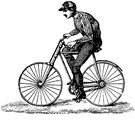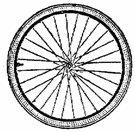The Wright Brothers: Bicycle Geniuses
Part 1: Mechanical from an Early Age Orville and Wilbur Wright were born tinkerers. From a very early age, they were fascinated by how things worked and how things were put together. They read about all kinds of subjects, including mechanics. Their mother was the family mechanic and encouraged them to learn everything she knew. They built their own printing press and then sold the business to open a bicycle shop. It is here where the story begins to get fascinating. The bicycle was introduced in France in the 18th Century (1790s). It was a little wooden horse with a front wheel attached. You couldn't steer it very well, but you could make it move and carry you down the street.
In the 1880s, the "safety bicycle" arrived. At once, it had three new elements: a chain, a rear wheel that had a sprocket, and wheels that were the same size. Not long after that, the use and improvement of bicycles increased rapidly.
Next came the idea of different speeds. A larger gear meant a lower gear; a smaller gear meant a higher gear. (The higher gears, then as now, required more effort to pedal but made you go faster.) Finally came the idea of putting the gears right under the pedals, in a part of the bike called the derailleur. This made it much easier to pedal and shift gears. Next page > Focus on the Air > Page 1, 2 |
|
Social Studies for Kids
copyright 2002–2025
David White



 In 1817, a German man named Karl von Drais invented a bicycle that had a large front wheel. (It was thought that the larger the front wheel, the faster the bike would go. This was true, to a certain extent, but not because of the size of the wheel.) Von Drais called this invention the "dandy horse."
In 1817, a German man named Karl von Drais invented a bicycle that had a large front wheel. (It was thought that the larger the front wheel, the faster the bike would go. This was true, to a certain extent, but not because of the size of the wheel.) Von Drais called this invention the "dandy horse." But this bicycle still didn't have pedals. Those would come from the mind of Kirkpatrick Macmillan, a blacksmith from Scotland. And it was from England that the last innovation approaching modern bicycles would come.
But this bicycle still didn't have pedals. Those would come from the mind of Kirkpatrick Macmillan, a blacksmith from Scotland. And it was from England that the last innovation approaching modern bicycles would come. In the early 1890s came the invention of pneumatic tires. These were rubber tires filled with compressed air. This was done so the air pressure inside the tire would keep the tire rolling around the bicycle rim.
In the early 1890s came the invention of pneumatic tires. These were rubber tires filled with compressed air. This was done so the air pressure inside the tire would keep the tire rolling around the bicycle rim.
